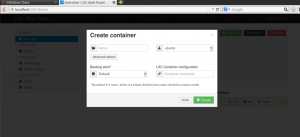
Is Docker for Suckers?
Recently we have been noticing an unusual surge in interest about Docker within the bioinformatics community. Here is a little review for their benefit.

What is Docker?
Docker helps you keep your server secure by encapsulating each programs so that a bad program does not bring down the entire server or a malicious program cannot take over the entire server. You can conceptually think about each unix process running in its controlled environment through Docker. You specify its own territory (RAM, disk, network port, etc.) before-hand and the program has to live within that territory.
Wow, isn’t that innovative?
Yes, it is, but the real innovation came the kernel developers of the Linux operating system.
cgroups (abbreviated from control groups) is a Linux kernel feature that limits, accounts for, and isolates the resource usage (CPU, memory, disk I/O, network, etc.) of a collection of processes.
Engineers at Google (primarily Paul Menage and Rohit Seth) started the work on this feature in 2006, under the name “process containers”.[1] In late 2007 the nomenclature changed to “control groups” due to the confusion caused by multiple meanings of the term “container” in the Linux kernel context, and control-group functionality merged into kernel version 2.6.24.[2] Since then, developers have added many new features and controllers, such as support for kernfs,[3] firewalling,[4] and unified hierarchy.[5]
One of the design goals of cgroups is to provide a unified interface to many different use cases, from controlling single processes (by using nice, for example) to whole operating system-level virtualization (as provided by OpenVZ, Linux-VServer or LXC, for example). Cgroups provides:
Resource limitation: groups can be set to not exceed a configured memory limit, which also includes the file system cache[6][7]
Prioritization: some groups may get a larger share of CPU utilization[8] or disk I/O throughput[9]
Accounting: measures how much resources certain systems use, which may be used, for example, for billing purposes[10]
Control: freezing the groups of processes, their checkpointing and restarting[10]
But who would write code at the kernel level? Docker makes that easy, no?
Well, there is another free and open-source program provided by the developers of linux (LXC) to do the job for you.
LXC (Linux Containers) is an operating-system-level virtualization environment for running multiple isolated Linux systems (containers) on a single Linux control host.
The Linux kernel provides the cgroups functionality that allows limitation and prioritization of resources (CPU, memory, block I/O, network, etc.) without the need for starting any virtual machines, and namespace isolation functionality that allows complete isolation of an applications’ view of the operating environment, including process trees, networking, user IDs and mounted file systems.[3]
LXC even has a user-friendly GUI to monitor processes. It cannot be any easier.

Who would be the best Docker users?
Docker and bioinformatics are match made in heaven. The current culture in bioinformatics is to run program as packages without understanding what is inside, and Docker takes not knowing what one does to an art form !! Let us explain that by reviewing various aspects of Docker and its ‘ecosystem’.
a) Dockerhub
Just like Github, Docker created Dockerhub to swap in and out packages. The difference with github is that you may be exchanging untrusted binaries. Remember, you invited Docker to your house in the first place to keep your place secure.
b) Libcontainer vs LXC
Docker started with relying on Linux LXC, which has gone through various rounds of review and updates to be secure. For example -
Originally, LXC containers were not as secure as other OS-level virtualization methods such as OpenVZ: in Linux kernels before 3.8, the root user of the guest system could run arbitrary code on the host system with root privileges, much like chroot jails.[4] Starting with the LXC 1.0 release, it is possible to run containers as regular users on the host using “unprivileged containers”.[5] Unprivileged containers are more limited in that they cannot access hardware directly. Nevertheless, even privileged containers should provide adequate isolation in the LXC 1.0 security model, if properly configured.[5]
Then somewhere along the way, it made its own libcontainer as the default container library. Remember, you invited Docker to your house in the first place to keep your place secure.
c) Docker on bare metal
Now that Docker does everything, a number of new ideas are being proposed about getting rid of much of operating system.
CoreOS and RancherOS are two such minimal operating systems.
If you are familiar with unix operating system, you know that ‘init’ is the first process (PID=1) and it starts a number of other processes. There is already a massive controversy in the linux community about systemd taking the place of init. According to linux veterans, systemd boots up the computer fast at the cost of security.
Between October 2013 and February 2014, a long debate among the Debian Technical Committee occurred on the Debian mailing list,[72] discussing which init system to use as the default in Debian 8 “jessie”, and culminating in a decision in favor of systemd. The debate was widely publicized[73][74] and in the wake of the decision the debate continues on the Debian mailing list.
…
In March 2014, Eric S. Raymond opined that systemd’s design goals were prone to mission creep and software bloat.[78] In April 2014, Linus Torvalds expressed reservations about the attitude of Kay Sievers, a key systemd developer, toward users and bug reports.[79]
In late April 2014, a campaign to boycott systemd was launched, with a website listing various reasons against its adoption.[80][81]
In an August 2014 article published in InfoWorld, Paul Venezia wrote about the systemd controversy, and attributed the controversy to violation of the Unix philosophy, and to “enormous egos who firmly believe they can do no wrong”.[82] The article also characterizes the architecture of systemd as similar to that of svchost.exe, a critical system component in Microsoft Windows with a broad functional scope.[82]
In November 2014, Debian maintainers and Technical Committee members Joey Hess,[83] Russ Allbery,[84] Ian Jackson[85] and systemd package maintainer Tollef Fog Heen[86] resigned from their positions. All three justified their decision on the public Debian mailing list and in personal blogs with their exposure to extraordinary stress levels related to ongoing disputes on systemd integration within the Debian and open source community that rendered regular maintenance virtually impossible.
In December 2014, a fork of Debian, called Devuan, was announced by a group calling themselves the “Veteran Unix Admins”. Its intention is to provide a Debian variant without systemd installed by default.[87]
Docker muddies the water even more, because it must also run as root or have the same privileges as systemd. CoreOs allows that by closely integrating Docker with its minimal operating system, whereas RancherOS goes a step further by giving Docker PID=1 !!
Remember, you invited Docker to your house in the first place to keep your place secure.
d) Lightweight?
It is true that Docker is lightweight compared to running a full virtual machine, but that should not be the basis of comparison. The real comparison should be LXC, and it appears that Docker limits the abilities of users compared to what LXC already provides.
Docker restricts the container to a single process only. The default docker baseimage OS template is not designed to support multiple applications, processes or services like init, cron, syslog, ssh etc.
As we saw earlier this introduces a certain amount of complexity for day to day usage scenarios. Since current architectures, applications and services are designed to operate in normal multi process OS environments you would need to find a Docker way to do things or use tools that support Docker.
Take a simple application like WordPress. You would need to build 3 containers that consume services from each other. A PHP container, an Nginx container and a MySQL container plus 2 separate containers for persistent data for the Mysql DB and WordPress files. Then configure the WordPress files to be available to both the PHP-FPM and Nginx containers with the right permissions, and to make things more exciting figure out a way to make these talk to each other over the local network, without proper control of networking with randomly assigned IPs by the Docker daemon! And we have not yet figured cron and email that WordPress needs for account management. Phew!
This is a can of worms and a recipe for brittleness. This is a lot of work that you would just not have to even think about with OS containers. This adds an unbelievable amount of complexity and fragility to basic deployment and now with hacks, workarounds and entire layers being developed to manage this complexity. This cannot be the most efficient way to use containers.
Can you build all 3 in one container? You can, but then why not just simply use LXC which is designed for multi processes and is simpler to use. To run multiple processes in Docker you need a shell script or a separate process manager like runit or supervisor. But this is considered an ‘anti-pattern’ by the Docker ecosystem and the whole architecture of Docker is built around single process containers.
If you are not satisfied, please take a look these excellent posts discussing Docker -
Understanding the key differences between LXC and Docker
Reddit: Docker is fundamentally flawed, useless hype (iops.io)
Reddit: Many reasons why you should stop using Docker (iops.io)